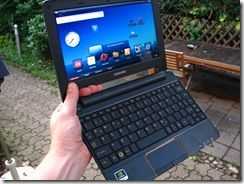 Despite the incomplete nature of these ‘smart’ books I’ve been testing, I’m still positive that the form factor and ARM-based processor has a lot to offer and that it will greatly influence the netbook of the future. People will say that the smart ‘book’ is dead but I guarantee that if Apple were to release a MacBook iAir running on iOS, the worlds axis would change and it would become the next best thing. Smart ‘books’ aren’t dead, they’re just gestating.
Despite the incomplete nature of these ‘smart’ books I’ve been testing, I’m still positive that the form factor and ARM-based processor has a lot to offer and that it will greatly influence the netbook of the future. People will say that the smart ‘book’ is dead but I guarantee that if Apple were to release a MacBook iAir running on iOS, the worlds axis would change and it would become the next best thing. Smart ‘books’ aren’t dead, they’re just gestating.
I’ll be continuing to test various devices with various operating systems and applications and in this video you’ll see me test a number of applications that are working out well on the AC100. Many applications don’t work well but the nice thing about a marketplace with thousands and thousands of applications in it is that you have options. All applications shown have been sideloaded using this method.
I have a 3G AC100 on order and am looking forward to new Froyo-based firmware soon so stay tuned for more testing.
In the video you’ll see Documents To Go, NewsRob, Raging Thunder, Wave Blazer, Astro, WordPress, Touiteur, Google Maps, Photoshop Express and XiiaLive.











I’d buy a smart book if it had an 8 inch screen (more space friendly in my bag) and ran something like Ubuntu. Ubuntu is probably the closest ARM compatible desktop OS to Windows’ or Mac OS’ user friendliness. It can also make use of hardware video acceleration through VA API (kind of like Microsoft’s DXVA but for Linux and UNIX). It should also have more capabilities than an Android port. Android is still not really a mature OS in the smart phone category (video capabilities, UI design, corporate security, etc.) let alone clamshell/notebook style devices.
Of course, if Microsoft or Apple makes their desktop OS’s ARM compatible, I’d prefer those over Ubuntu.
Considering the CPU data of typical smartbook platforms, I guess Windows 7 wouldn’t be a good choice though. Let alone the lack of arm-compiled Windows-software. After all, a ported OS alone won’t help that much.
Its easier for Ubuntu, using open source software – but then again I’m not sure, whether porting the programs to an ARM-Ubuntu is as easy as recompiling them.
For instance we need to consider that Desktop-OS-Software usually isn’t written with battery life in mind – The Pidgin messenger alone bumps up the power usage of my netbook by 1W according to powertop when running in the background. Sure, such things are problems to x86-Notebooks too, but I can’t see pidgin easily making use of passive surveilance of instant messages in a low-power idle state.
Anyone there knowledgeable about mobile platforms and instant messaging? I wonder if ICQ, AIM, Skype, Jabber, MSN and the like even allow a power saving centered implementation by the requirements of their protocols.
You bring up a good point – management of applications access to facilities. Apple does this very well but in an open-source Linux system it’s really difficult to manage.
It’s already the case on Maemo since before the iPhone was born: to be perfectly integrated, apps have to follow some specifications designed for MIDs.
But it’s not enforced with a knife under the throat, people have the choice to install simply rebuilt apps. In many cases, that’s well enough. And if it’s not, anyone can patch it.
“People will say that the smart ‘book’ is dead but I guarantee that if Apple were to release a MacBook iAir running on iOS, the worlds axis would change and it would become the next best thing. Smart ‘books’ aren’t dead, they’re just gestating.”
Nah. That’s why Apple isn’t in the “Smartbook” market. But then again, they aren’t successful everywhere. Ever heard of “Apple TV”?